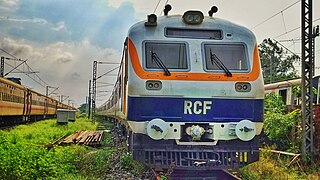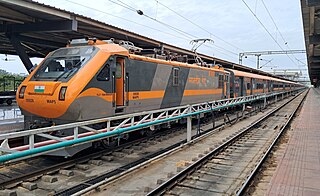
Indian locomotive class WAP-5 is a class of electric locomotives used by Indian Railways. The first ten locomotives were imported from ABB in Switzerland in 1995 and later manufactured by Chittaranjan Locomotive Works in India. On 3 July 2014, a WAP-5 set an Indian speed record by hauling a train between Delhi and Agra at a speed of 160 km/h (99 mph). The locomotive has regenerative braking, flexible gear coupling, wheel-mounted disc brakes, and a potential for speed enhancement to 200 km/h (120 mph). Braking systems include 160 kN (36,000 lbf) regenerative brakes, disc brakes, automatic train air brakes and a charged spring parking brake.

Integral Coach Factory is an Indian manufacturer of rail coaches. Established in 1955, it is located in Perambur in Chennai and is the largest rail coach manufacturer in the world. It is owned and operated by the Indian Railways and is the oldest amongst the five rake production units of the Indian Railways. While the facility initially manufactured ICF coaches, it currently manufactures LHB coaches and electric multiple units including the semi-high speed Vande Bharat train-sets.

Indian Railways operates India's railway system and comes under the purview of the Ministry of Railways of Government of India. As of 2023, it maintains over 108,706 km (67,547 mi) of tracks and operates over 13,000 trains daily. According to the Ministry of Railways, a route capable of supporting trains operating at more than 160 km/h (100 mph) is considered as a higher speed or semi-high speed rail line.

In Indian Railways, a MEMU is an electric multiple unit (EMU) train that serves short and medium-distance routes in India, as compared to normal EMU trains that connect urban and suburban areas. The acronym stands for Mainline Electric Multiple Unit.

India has a system of express trains, operated by Indian Railways which comes under the purview of the Ministry of Railways of Government of India. As of 2023, it maintains over 108,706 km (67,547 mi) of tracks, spanning across 68,584 km (42,616 mi) in route length, and operates nearly 3,000 express trains daily. According to the Ministry of Railways, express trains travel faster and have limited stops than ordinary passenger trains. Any passenger train with an average speed higher than 55 km/h (34 mph) is considered super-fast.

The 12049 / 12050 Gatiman Express is an express train run by Indian Railways. It connects Hazrat Nizamuddin in Delhi and Jhansi railway stations.
The Indian Government is undertaking several initiatives to upgrade its aging railway infrastructure and enhance its quality of service. The Railway Ministry has announced plans to invest ₹5,400,000 crore to upgrade the railways by 2030. Upgrades include 100% electrification of railways, upgrading existing lines with more facilities and higher speeds, expansion of new lines, upgrading railway stations, introducing and eventually developing a large high-speed train network interconnecting major cities in different parts of India and development of various dedicated freight corridors to cut down cargo costs within the country.

The Tejas Express is a semi-high speed fully air-conditioned train introduced by Indian Railways. It features modern onboard facilities with doors which are operated automatically. Tejas means "sharpness", "lustre", or "brilliance" in many Indian languages. It is one of 3 semi-high speed trains running in India, the others being the Vande Bharat Express and the Gatimaan Express.

The Vande Bharat sleeper trainset, formerly known as Train-20 is a semi-high-speed, long-distance electric multiple unit (EMU) train, designed to replace the Rajdhani Express. It is being developed based on the existing short-distance Vande Bharat trainset, differing in exterior body, sleeping berths, and onboard amenities due to its long-distance service.

Titagarh Rail Systems Limited, is an Indian rolling stock manufacturer. Established in 1984 as a rolling stock foundry unit, the company's headquarters are situated in Kolkata, West Bengal. Titagarh is publicly traded on both the Bombay Stock Exchange (BSE) and National Stock Exchange (NSE).

Vande Bharat Express is a medium to long-distance superfast express service operated by Indian Railways. It is a reserved, air-conditioned chair car service connecting cities that are less than 800 km (500 mi) apart or take less than ten hours to travel with existing services and a planned reserved, air-conditioned sleeper service connecting cities that are 800 km (500 mi) to 1,200 km (750 mi) apart. The train was a part of the 'Make in India' initiative by the government and entered commercial service on 15 February 2019.
A multiple-unit train or simply multiple unit (MU) is a self-propelled train composed of one or more carriages joined together, which when coupled to another multiple unit can be controlled by a single driver, with multiple-unit train control. Although multiple units consist of several carriages, single self-propelled carriages, such as railbuses and trams – are in fact multiple-units when two or more of them are working connected through multiple-unit train control.

The 22436/22435 New Delhi - Varanasi Jn Vande Bharat Express is India's 1st semi-high speed, electric multiple unit train, connecting the states of New Delhi and Uttar Pradesh.

The 20825/20826 Bilaspur - Nagpur Vande Bharat Express is India's 6th Vande Bharat Express train, connecting the states of Chhattisgarh and Maharashtra.

The 20977/20978 Ajmer - Chandigarh Vande Bharat Express is India's 14th Vande Bharat Express train, connecting the states of Rajasthan, Punjab, Haryana, New Delhi and Chandigarh. This express train is an extension of the former Vande Bharat Express train which ran from Ajmer Junction till Delhi Cantonment.

The Namo Bharat is an Indian electric multiple unit (EMU) train built for RapidX. The train was designed by the French rolling stock manufacturer Alstom at its engineering centre in Hyderabad, Telangana, and was manufactured in Savli, Gujarat. The train has an aerodynamic design which reduces the drag when it travels. The train has a design speed of 180 km/h (110 mph) and is operated at a speed of 160 km/h (99 mph).

The Vande Bharat trainset, formerly known as Train 18, is an Indian electric multiple unit chair car trainset designed and developed by Indian Railways at its Integral Coach Factory in Chennai. The train achieved a maximum speed of 183 km/h (114 mph) during its trial runs but the operational speed of the train is restricted to 160 km/h (99 mph) due to tracks' inability to support such speeds.

Amrit Bharat is an Indian push-pull train, designed and developed by Indian Railways at its Integral Coach Factory in Chennai. It has non-air-conditioned three-tier sleeper and unreserved coaches.

The Amrit Bharat Express is a superfast express service operated by Indian Railways. It is a non-air-conditioned, low-cost, sleeper cum unreserved service connecting cities that are more than 800 km (500 mi) apart or take more than ten hours to travel with existing services. The trainset consists of two locomotives, one on either side and 22 coaches with a maximum operating speed of 110–130 km/h (68–81 mph). The train entered commercial service on 1 January 2024.

Namo Bharat Rapid Rail is a short-distance service that operates on an inter-city rail network to connect major cities within a distance of around 100–250 km (62–155 mi). RCF Kapurthala, had rolled out the first Basic Unit of Namo Bharat Rapid Rail in April 2024. This train will be part of the 'Make in India' initiative by the Government of India and entered commercial service in September 2024.
















